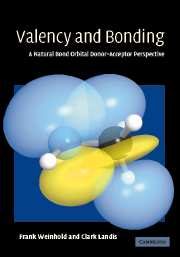Book contents
- Frontmatter
- Contents
- Preface
- 1 Introduction and theoretical background
- 2 Electrostatic and ionic bonding
- 3 Molecular bonding in s/p-block elements
- 4 Molecular bonding in the d-block elements
- 5 Supramolecular bonding
- Appendix A Methods and basis sets
- Appendix B Chemical periodicity
- Appendix C Units
- Chemical-species index
- Author index
- Subject index
2 - Electrostatic and ionic bonding
Published online by Cambridge University Press: 04 December 2009
- Frontmatter
- Contents
- Preface
- 1 Introduction and theoretical background
- 2 Electrostatic and ionic bonding
- 3 Molecular bonding in s/p-block elements
- 4 Molecular bonding in the d-block elements
- 5 Supramolecular bonding
- Appendix A Methods and basis sets
- Appendix B Chemical periodicity
- Appendix C Units
- Chemical-species index
- Author index
- Subject index
Summary
Introduction
The close relationship between chemistry and electricity was surmised long before the discovery of quantum mechanics. The inverse-square law for the force between electrically charged objects (“Coulomb's law”) was established as early as 1766 by the American chemist Joseph Priestley, on the basis of a method suggested by Benjamin Franklin. Galvani's discoveries of 1780 and the subsequent development of the voltaic pile sparked intensive investigations on the chemical effects of electricity, culminating in Humphry Davy's electrolytic discoveries of alkali elements and general recognition of the “natural electrical energies of the elements” by about 1806. Within a decade, J. J. Berzelius had formulated his influential “dualistic” electrochemical theory, asserting that “in every chemical combination there is a neutralization of opposite electricities.”
Studies of electrolysis and electromagnetic induction were greatly advanced by Davy's assistant, Michael Faraday, who also introduced the modern terminology of “cation” and “anion.” Long before the 1897 “discovery” of the electron by J. J. Thomson, strong chemical evidence pointed to the existence of such “corpuscles of electricity,” as could be inferred particularly from Faraday's studies. Indeed, the word “electron” was coined in 1874 by the chemist J. Stoney, who also estimated the electronic charge from the value of Faraday's constant. Thus, the essential components of a simple ionic bonding picture, much as presented in current textbooks, were available at least a half-century before the discovery of Schrödinger's equation and the modern quantal view of electronic behavior.
Although the Berzelius ionic theory achieved successes in interpreting inorganic compounds, it met persistent difficulties in the emerging domain of organic chemistry.
- Type
- Chapter
- Information
- Valency and BondingA Natural Bond Orbital Donor-Acceptor Perspective, pp. 45 - 88Publisher: Cambridge University PressPrint publication year: 2005

